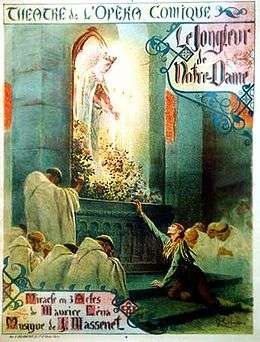Le jongleur de Notre-Dame
| Le jongleur de Notre-Dame | |
|---|---|
| Opera by Jules Massenet | |
 Poster for the first Paris production, depicting the closing scene | |
| Librettist | Maurice Léna |
| Language | French |
| Based on |
Le jongleur de Notre-Dame by Anatole France |
| Premiere |
18 February 1902 Opéra de Monte-Carlo |
Le jongleur de Notre-Dame is a three-act opera (labelled in the programme as Miracle in Three Acts) by Jules Massenet to a French libretto by Maurice Léna. It was first performed at the Opéra Garnier in Monte Carlo on 18 February 1902.[1]
History
It is based on the story of the same name by Anatole France in his collection L'Étui de nacre, which was in turn based on a 13th-century medieval legend by Gautier de Coincy, c. 1220. The role of Jean the juggler was popularised in the United States by the famous soprano, Mary Garden, which, according to some sources, horrified composer Massenet, who meant the role for a tenor. Garden's undertaking of the role was in the tradition of actresses of that era playing Peter Pan.
The opera was popular in the early part of the twentieth century, due partly to Mary Garden's appearances in it, but it soon disappeared from the world's stages, as did many of Massenet's other operas. Up to the early 1950s however, it received 356 performances at the Opéra-Comique in Paris.[2]
In 1978 the complete opera was recorded in stereo for the first time, and this recording, with the tenor Alain Vanzo as Jean and Jules Bastin as Boniface, was reissued on compact disc in 2003, followed by another CD containing a live radio performance of the work, again with Vanzo. This has subsequently led to new revivals of the opera in the United States, sometimes in more modern dress.
Roles
| Role | Voice type | Premiere Cast,[3] 18 February 1902 (Conductor: Léon Jehin) |
|---|---|---|
| Jean | tenor | Adolphe Maréchal |
| Boniface | baritone | Maurice Renaud |
| Prior | bass | Gabriel Soulacroix |
| A poet monk | tenor | Berquier |
| A painter monk | baritone | Juste Nivette |
| A musician monk | baritone | Grimaud |
| A sculptor monk | bass | Crupeninck |
| Singer monk | baritone | Senneval |
| Monk, on guard duty | baritone | Delestang |
| A fellow | baritone | Borie |
| A drunkard | bass | Albert Paillard |
| A knight | tenor | Jacobi |
| 1st angel | soprano | Marguerite de Buck |
| 2nd angel | soprano | Marie Girerd |
| Apparition of the virgin | mute | Siméoli |
| A voice | baritone | |
| Townspeople, Knights, Clerks, Peasants, Beggars, Young girls and boys, Market-people ; Monks, Angelic voices. | ||
Synopsis
- Place: France
- Time: Medieval period
Jean, a juggler, is severely taken to task by the Prior for singing vulgar songs outside the local monastery. Seeing that Jean is filled with remorse, the Prior asks him to join the order of monks. Jean does so, and is befriended by the monastery's cook, Boniface who tells him the legend of the sagebush which opened its branches to shelter the Infant Jesus as He slept. When Jean sees that the other monks are offering lavish and beautiful gifts to the newly completed statue of the Virgin Mary, he, having no real gift, resolves to do what he can do best. He sneaks into the chapel late at night and juggles before the statue until he collapses from exhaustion.
The other monks enter, horrified, and are about to seize Jean to reprimand him for blasphemy, when a heavenly light begins to glow and a miracle occurs — the statue of the Virgin comes to life and blesses Jean (in some productions, she merely holds out her hands in benediction, in others she tosses him a rose, and in Anatole France's original story, she descends from her pedestal and wipes Jean's brow with a handkerchief, but in most versions of the opera, she smiles down at him). Jean at first is totally unaware of anything, but suddenly cries out that he finally understands Latin (the traditional language of the Catholic Mass). He sees the Virgin ascending to Heaven and beckoning him to follow. In ecstasy, he falls back dead. The other monks, awed by the sight, declare that they have been in the presence of a saint.
Recordings
Soulacroix recorded the Prieur's air, which he created, for Pathé in 1902/1903. Mary Garden, David Devriès, Marcel Claudel and Géori Boué popularized the aria "Ô liberté, ma mie". The 'Légende de la sauge' for Boniface has been recorded many times, singers including Paolo Ananian in 1907, Antonio Magini-Coletti in 1909 in Italian, Louis Dupuoy (as Jean Duez) in 1910, Edouard Rouard in 1921, Giuseppe Danise in 1926, Lucien Fugère in 1928, Etienne Billot in 1928, Vanni Marcoux in 1930, Roger Bourdin in 1933 and Michel Dens in 1947.
There have been two complete studio recordings:
- 1978: Alain Vanzo (Jean), Jules Bastin (Boniface), Marc Vento (le Prieur); Orchestra and Chorus of the Opéra de Monte-Carlo, Roger Boutry (EMI-Pathé)
- 2007: Roberto Alagna (Jean), Stefano Antonucci (Boniface), Francesco Ellero d’Artegna (le Prieur). Orchestre National de Montpellier Languedoc-Roussillon, Enrique Diemecke (DG)
References
- ↑ Milnes R. Le jongleur de Notre-Dame. In: The New Grove Dictionary of Opera. Macmillan, London and New York, 1997.
- ↑ Wolff, Stéphane. Un demi-siècle d'Opéra-Comique (1900–1950). André Bonne, Paris, 1953.
- ↑ Le Jongleur de Notre-Dame webpage at the French Art Lyrique website accessed 5 September 2014.
Works cited
- Upton, George P.; Borowski, Felix (1928). The Standard Opera Guide. New York: Blue Ribbon Books. pp. 191–93.
- Kobbé, Gustav (1976). The Complete Opera Book. New York: G.P. Putnam's Sons. pp. 873–875.
External links
- Opera libretto (in English)